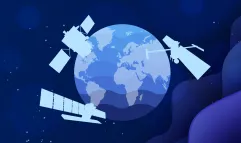2023 has been the hottest year on record, like those before it. As the planet inexorably overheats, we’re seeing more frequent extreme events like typhoons, wildfires and storms, with windstorm Ciarán leaving a trail of destruction along France’s western seaboard in October. The cause? Human activities, including the growth in digitalization, involving infrastructure and operations that are disrupting Earth’s delicate climate balance. With the environmental footprint of these technologies fast becoming a key challenge for the future, all eyes are on space in search of a long-term alternative.
We spoke to Damien Dumestier, in charge of the ASCEND feasibility study at Thales Alenia Space.
How would you describe the ASCEND project?
The ASCEND project — Advanced Space Cloud for European Net zero emission and Data sovereignty — is studying the technical and environmental feasibility of creating space-based datacenters to potentially reduce the ecological impact of processing and storing data. The project is being pursued on behalf of the European Commission under the European Union’s Horizon Europe Framework Program for Research and Innovation covering the period from 2021 to 2027.
The feasibility study will ultimately allow us to establish the potential benefits of this project and define our position on its utility. As part of this study, Thales Alenia Space has been coordinating a consortium of 11 partners since January 2023, including companies specializing in environmental impact analysis. A project as innovative as this is founded on close collaboration between the consortium partners contributing their complementary areas of expertise.
To what extent does the solution meet the challenges involved in combating global warming?

ASCEND © Thales Alenia Space
As the need for digital technologies continues to grow, so does the number of datacenters in Europe and around the world. And their non-negligible energy and environmental impacts are compounding digital pollution.
The main aim of the study is to determine whether we can build and launch space-based datacenters with a significantly lower environmental impact than their Earth-based counterparts. Focusing first on the carbon footprint of Europe’s terrestrial datacenters, we established that they’ll consume a total of 20 million tonnes of CO2 equivalent a year between now and 2030. This data allows us to define the carbon footprint threshold of space-based datacenters. Ultimately, ASCEND aims to significantly reduce the impact of datacenters, targeting a power capacity of 10 TWh to cut the energy requirements of Earth-based datacenters by 10%.
According to our initial studies, this project could also deliver benefits in other areas of the environment. For example, water consumption would be greatly reduced — a crucial aspect given that several tens of millions of liters are currently required every year to cool Earth-based datacenters. With periods of drought becoming increasingly frequent, finding an alternative is therefore of prime importance. Space is naturally cold, which would keep spacecraft structures and systems cool without additional energy or resources.
What are the challenges of getting the ASCEND project into orbit?
The main challenge with the ASCEND project is to find an architecture that meets the specific operational needs of a datacenter in space while significantly reducing Europe’s environmental footprint and energy consumption. We’re studying architectures that let us take advantage of the scaleup factor and optimize the structure. A capacity of 10 MW per space datacenter is envisaged, which would require a solar panel surface area of about 35,000 square meters (375,000 sq.ft). By comparison, the International Space Station has an equivalent surface area of 7,500 square meters (80,730 sq.ft).
The modules to be deployed in orbit will therefore be larger and heavy, so we’re currently taking a long hard look at launchers. We need to make sure that a suitable launch solution can be developed and that the overall structure is as light as possible to minimize the carbon footprint of launch operations. Optimizing payload weight and volume will also be a key challenge.
This project offers a great opportunity for the European Union and could help meet the Green Deal’s goal of net-zero carbon by 2050. It would mark an unprecedented development for Europe’s space and digital ecosystem.
Do you think this solution could actually be developed in the future?
Projects like this can both revolutionize space technologies and help reduce the environmental footprint of digital technology. I believe space is vital for our future because it offers multiple possibilities to complement terrestrial infrastructures. And it’s an unparalleled asset to better manage the delicate balance between developing human activities and protecting the environment.
The results of the ASCEND feasibility study are due in April 2024.


